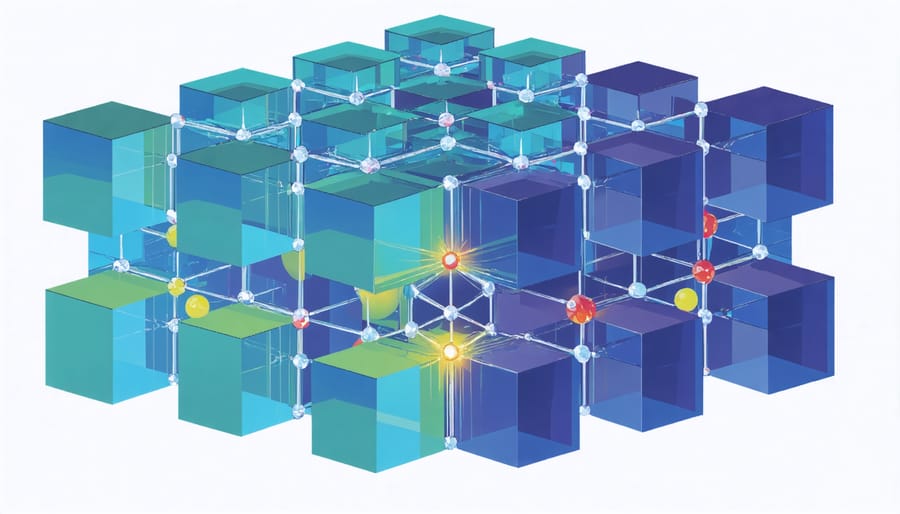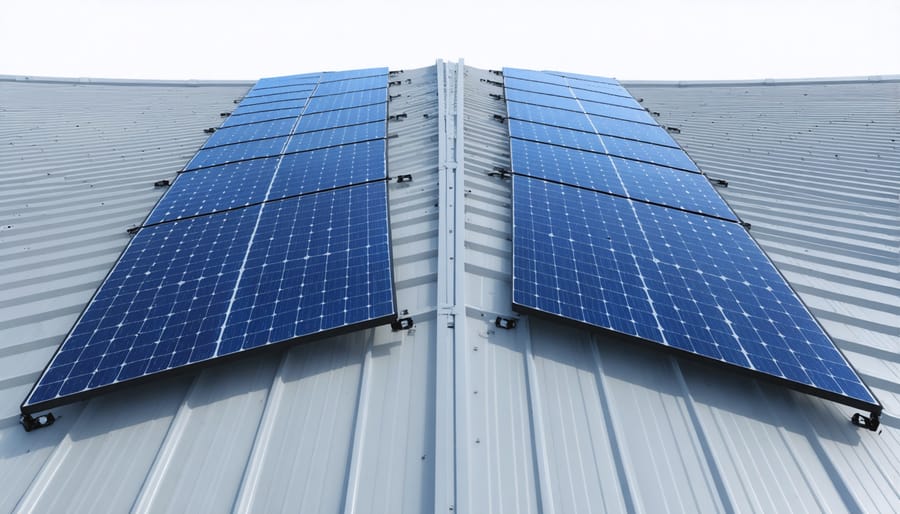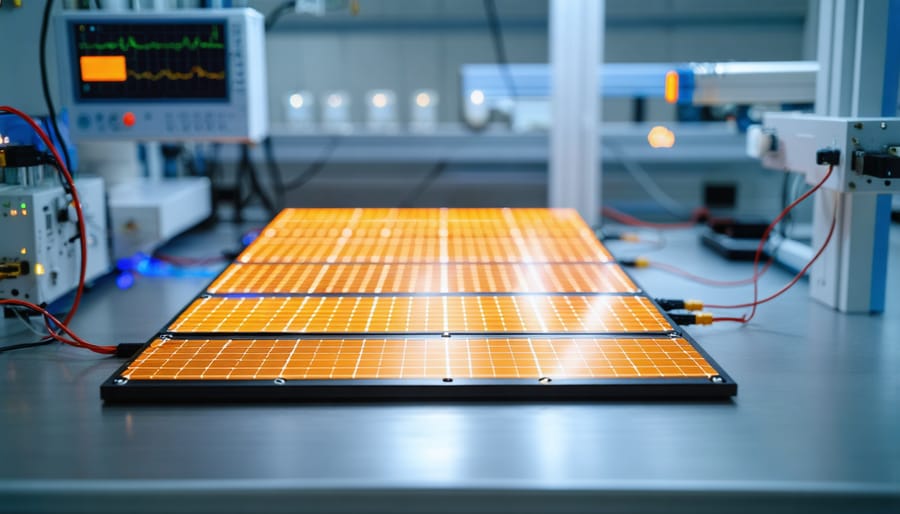Halide Perovskites: The Breakthrough Making Solar Panels More Affordable
Revolutionizing solar energy, halide perovskites represent one of the most promising breakthroughs in renewable technology of the past decade. These remarkable materials have captured the attention of scientists and energy experts worldwide by achieving unprecedented solar cell efficiency rates – jumping from 3.8% to over 25% in just ten years. Unlike traditional silicon-based solar cells, perovskites can be produced using simple, room-temperature processes, potentially slashing manufacturing costs and making solar power more accessible to homeowners everywhere.
Think of perovskites as the next-generation solar material that combines the best of both worlds: high performance and cost-effectiveness. These crystals can be printed like newspapers, sprayed like paint, or processed into flexible sheets, opening up exciting possibilities for solar panels that can curve around buildings or integrate seamlessly into windows. For homeowners and businesses looking to embrace clean energy, halide perovskites could soon deliver more affordable and versatile solar solutions that transform how we power our world.

Why Halide Perovskites Are Changing Solar Energy
Cost-Effective Manufacturing
One of the most exciting aspects of halide perovskites is their potential to dramatically reduce solar panel manufacturing costs. Unlike traditional silicon cells that require high-temperature processing (around 1,000°C) and ultra-pure materials, perovskites can be produced at much lower temperatures (below 150°C) using simpler methods. This energy-efficient production process translates directly into lower manufacturing costs.
The materials themselves are also more affordable. Perovskites can be created using abundant, inexpensive raw materials and can be applied to surfaces using techniques as simple as inkjet printing or roll-to-roll processing – similar to newspaper printing. These manufacturing methods are particularly promising for hybrid solar systems, where perovskites can be layered with existing silicon technology.
When scaled up to commercial production, experts estimate that perovskite solar panels could cost up to 70% less than traditional silicon panels, making solar energy more accessible to homeowners and businesses alike. This cost reduction, combined with their impressive efficiency rates, positions perovskites as a game-changing technology for affordable renewable energy.
Enhanced Light Absorption
One of the most remarkable features of halide perovskites is their exceptional ability to absorb light. These materials can capture sunlight much more effectively than traditional silicon solar cells, requiring only a thin layer to achieve impressive power conversion. Think of it like comparing a thick sponge to a super-absorbent paper towel – the perovskite layer can be about 100 times thinner than silicon while capturing the same amount of sunlight.
This enhanced light absorption means that perovskite solar cells can generate more electricity from less material. When sunlight hits a perovskite layer, it efficiently converts photons into electrical charge carriers, even in low-light conditions or at different angles. This makes them particularly effective for cloudy days and north-facing installations.
What’s more, perovskites can be tuned to absorb different parts of the solar spectrum by adjusting their chemical composition. This flexibility allows manufacturers to create solar cells that capture more of the available sunlight, potentially pushing efficiency ratings beyond what traditional solar panels can achieve. For homeowners, this translates to more power generation from a smaller roof area.
Real-World Applications for Homeowners
Flexible Solar Panels
One of the most exciting developments in perovskite solar technology is its potential for flexible applications. Unlike traditional rigid silicon panels, halide perovskite solar cells can be manufactured on bendable substrates, opening up a world of installation possibilities. These flexible panels can conform to curved surfaces, making them perfect for architectural elements like domes, cylindrical structures, and even vehicle roofs.
Homeowners can now integrate solar power into their properties in ways previously impossible. Imagine solar panels that follow the gentle curve of a barrel-tiled roof or wrap around a circular water tank. When combined with modern home energy storage solutions, these adaptable panels create truly customized renewable energy systems.
The installation process is remarkably straightforward, with panels that can be rolled out like carpet or applied as adhesive sheets. This flexibility not only makes installation easier but also reduces labor costs significantly. Commercial buildings with unique architectural features can now harness solar power without compromising their design aesthetic.
Beyond buildings, these flexible panels are finding applications in portable devices, camping equipment, and even clothing. Their lightweight nature and ability to maintain efficiency while bent make them ideal for mobile applications where traditional rigid panels would be impractical.

Indoor Light Harvesting
One of the most exciting applications of halide perovskites is their exceptional performance in indoor and low-light conditions. Unlike traditional solar cells that require direct sunlight to generate significant power, perovskite cells can efficiently harvest energy from artificial lighting sources like LED bulbs, fluorescent lights, and even dim natural light filtering through windows.
This unique capability makes perovskite cells ideal for powering indoor smart devices, sensors, and Internet of Things (IoT) gadgets. For example, a small perovskite cell can generate enough power from office lighting to run wireless sensors that monitor temperature, humidity, and air quality. This eliminates the need for battery replacements and reduces electronic waste.
Commercial buildings can particularly benefit from this technology. By installing perovskite-based devices in well-lit areas, property managers can power security systems, environmental controls, and other low-power electronics using the existing indoor lighting infrastructure. Some innovative companies are already incorporating these cells into smart blinds and window treatments that harvest both natural and artificial light.
The efficiency of perovskite cells under indoor conditions can reach up to 30%, significantly higher than conventional silicon cells in similar settings. This impressive performance, combined with their thin, lightweight nature, opens up countless possibilities for integrating sustainable power generation into our indoor environments.

Current Challenges and Solutions
Durability Improvements
Scientists and manufacturers have made remarkable strides in addressing the durability challenges that initially held back perovskite solar cells. One breakthrough came from adding protective layers that shield the sensitive perovskite material from moisture and oxygen, much like a raincoat protects us from the elements. These protective coatings have helped extend the lifespan of perovskite cells from mere months to several years.
Another game-changing innovation involves mixing different halide materials to create more stable structures. By combining various compounds, researchers have developed perovskite formulations that can withstand higher temperatures and maintain their efficiency longer. Some of these enhanced cells have shown promising results in real-world testing, maintaining over 90% of their original performance after a year of outdoor exposure.
Manufacturing techniques have also evolved, with new methods like vacuum sealing and specialized encapsulation helping to lock out harmful environmental factors. These improvements mean today’s perovskite cells can better handle the challenges of daily use, from temperature fluctuations to humidity changes, making them increasingly practical for home solar installations.
Environmental Considerations
While halide perovskites show incredible promise for advancing solar technology, their environmental impact requires careful consideration. The good news is that researchers are making significant strides in developing eco-friendly manufacturing processes and safer materials.
One of the main environmental concerns has been the use of lead in traditional perovskite formulations. However, scientists are now successfully developing lead-free alternatives using tin and bismuth, which offer similar performance while being more environmentally friendly. These newer formulations reduce the potential risks of toxic material leaching into soil or groundwater.
Recycling initiatives are also gaining momentum, with new methods being developed to recover and reuse perovskite materials from old solar cells. This circular approach helps minimize waste and reduces the environmental footprint of production.
Manufacturers are implementing strict safety protocols during production, including advanced containment systems and protective equipment. These measures ensure worker safety and prevent environmental contamination. Additionally, ongoing research focuses on making perovskite solar cells more durable, which naturally extends their lifespan and reduces the need for frequent replacements.
Future Outlook
The future of halide perovskites looks incredibly promising, with experts predicting widespread market adoption within the next 5-10 years. As manufacturing processes become more refined and efficient, we can expect to see these solar cells appearing on residential rooftops and commercial buildings across the globe.
Several major breakthroughs are on the horizon. Scientists are working on improving the stability of perovskite cells, with new protective coatings and encapsulation techniques showing great potential. We’re likely to see perovskite solar panels that can last 25 years or more, matching the lifespan of traditional silicon panels while offering superior performance.
Another exciting development is the emergence of tandem cells, which combine perovskites with existing silicon technology. These hybrid solutions could push solar efficiency beyond 30%, potentially revolutionizing the renewable energy landscape. This means homeowners could generate significantly more power from the same roof space.
Cost-wise, industry analysts project that perovskite solar panels could be up to 50% cheaper than current silicon options by 2025. This price drop, combined with improved efficiency, could make solar energy accessible to millions more households and businesses worldwide.
The technology is also opening doors for innovative applications, like transparent solar windows and flexible solar films that can be integrated into building materials. These advances could transform our cities into solar power plants, helping us achieve a more sustainable future.
Halide perovskites represent a game-changing advancement that could revolutionize residential solar adoption in the coming years. As manufacturing processes become more refined and costs continue to decrease, homeowners can look forward to solar panels that are not only more efficient but also more affordable. The potential for achieving higher energy conversion rates means smaller installations could generate the same amount of power as traditional systems, making solar more accessible for properties with limited roof space.
The flexibility of perovskite technology also opens up exciting possibilities for integration into building materials, from windows to roof tiles, allowing homeowners to generate clean energy without compromising their property’s aesthetics. While some challenges remain, particularly regarding long-term durability, ongoing research and development suggest these hurdles will soon be overcome.
As we move toward a more sustainable future, halide perovskite solar cells stand poised to make clean energy more accessible and practical for everyday homeowners, potentially accelerating our transition to renewable energy and reducing our collective carbon footprint.






